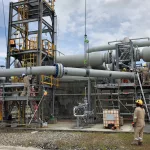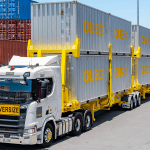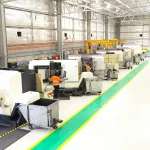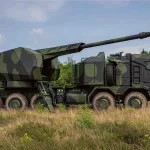Warehouses of today are often equipped with the latest solutions available in order to improve operational processes. Increasingly preferred over manual solutions, variations of modern Warehouse Management Systems (WMS) are becoming ever popular with savvy companies who value both the hardware and software-related benefits that automated solutions offer.
Providing a high degree of standardisation, visibility and flexibility to automated warehousing operations, WMS solutions have truly simplified logistical processes. Through the WMS, warehouse efficiency enhances an operator’s experience, achieves product traceability, and optimises workflow for companies to attain long-term benefits.
As an important element of automated warehousing systems, auto-identification technology is often incorporated within robust WMS applications. Specifically, barcode and Radio-Frequency Identification (RFID) technology are the two common options for managing inventory in warehouse and distribution facilities. Although a small number of WMS-equipped sites may still rely on some form of manual data entry, the majority of automated warehouses utilise barcode technology, with some employing RFID to complement or support barcoded items.
BARCODES AND RFID
Visually represented as a set of vertical lines with varying thicknesses, barcodes carry a fixed and relatively-limited amount of information. Recognised as the backbone of WMS, barcodes today are perceived as the norm for consumer product inventory management, and are ubiquitous in retail stores and supermarkets, as well as in warehouses around the world.
On the other hand, Radio-Frequency Identification (RFID) technology is a more sophisticated option for auto-identification. Using radio-frequency waves to transfer data between a reader and a tagged item, RFID can be employed for identification, categorisation and tracking purposes. It has a much larger capacity for data, and is orientation independent, capable of operating without line-of-sight.
So, how do companies decide on which auto-identification technology to use? Manufacturers often simply select barcoding, the option that is perceived to be lower in cost and easier to operate. However, this may not always be true. Depending on factors such as the condition of the warehouse, type of products, and size of operation, RFID technology may perhaps be the better alternative to ensure both immediate and long-term success of warehouse operations.
PRODUCTIVITY AND EFFICIENCY
The barcoding process (printing, pasting, scanning) facilitates the WMS in tracking inventory movement throughout the warehouse while delivering real-time information simultaneously. Inventory with barcode labels are speedily allocated storage locations by the WMS, and can be easily retrieved when required. Barcodes can also be quickly and easily reprinted, thus reducing downtime, and can be programmed to guide warehouse operators so they avoid making recurring mistakes during receiving and picking processes. Although modest in execution, barcoding solutions can help to improve productivity and efficiency of a warehouse.
For added productivity and efficiency, however, RFID technology may be a better option within a WMS that requires higher levels of sophistication in the automation process. An embedded data chip within the RFID tag allows recording of additional information that can be transmitted to the WMS, allowing a two-way interaction (WMS to RFID; RFID to WMS), whereas due to the one-way nature of the barcode, a WMS with barcoded inventory is limited to only extracting information. Beyond the integrated circuit (IC) chip used for information storage, the material (plastic, rubber, metal) used for RFID tags can also be customised to different products and operations, enhancing the use of RFID for greater productivity.
A major strength of RFID-tracking is that line-of-sight is not required. Using radio waves, the technology does not require an obvious tag that can be “seen”, as is the case for manual recording. With RFID, pallet tags, shelf tags, or even floor tags can all be incorporated as part of a WMS for operators to efficiently handle location and product data management. Instead of tearing down pallets and cases to individually scan items, operators using RFID systems can enjoy automatic recording and updating of information to the WMS. This eliminates the time-consuming process of manually scanning each item, thus increasing productivity levels, and in fact also preventing errors.
SPEED AND ACCURACY
Another important factor to consider is the speed and accuracy of a chosen auto-identification technology. With barcode technology, product and pallet readings at either incoming or outgoing stages in a warehouse process can be relatively slow, laborious, and are more susceptible to human errors. For large items of low product count, barcodes may be a sufficient and better option, but for goods in larger quantities and smaller item size, an RFID- equipped system will likely offer much greater speed and accuracy.
Through its flexible reading capabilities, RFID-tagged objects can be read in various orientations at very high speeds (about 40 RFID tags can be read at the same time), outshining barcodes, which can only be scanned individually. Unlike RFID, barcode scanners require a direct and unobstructed line of sight to perform a reading, limiting the system’s ability to work from a distance.
A significant time saver for logistical processes, RFID supports accurate warehouse inventory management, and stores valuable data, allowing companies to collect business analytics on inventory anywhere within a warehouse. This way, the technology helps manufacturers to increase inventory accountability and also reduces the time taken for stock count, since inventory updates can be recorded constantly. RFID readers can also be set up in read zones, which are specific warehouse spots that are outfit with sensors, so that any item brought into or out of the zone can be read and monitored, further assisting in inventory accuracy.
SECURITY
Where security is concerned, barcodes have more to catch up on due to the ease of reproduction and forgery of labels. Additionally, standard barcodes simply identify manufacturer and product, but without the use of WMS, are unable to store unique item information, such as manufacturing or expiration dates.
In contrast, RFID technology can be harnessed within a WMS to provide a host of security capabilities. An RFID- equipped WMS can capture information for when tagged items are removed from storage locations, therefore deterring product theft and reducing inventory loss. Manufacturers can then track missing items with each product’s specific identification number.
In designing the RFID tags, data can also be protected and layered with password encryption protocols to guard against unforeseen circumstances. This affords RFID technology with higher security levels, further enhancing value to the identification solution.
COST
Cost is most often the top reason for manufacturers to decline RFID-technology adoption in warehousing facilities, as many take it for granted that RFID equipment and running costs are significantly higher than that of barcode technology. With a series of stages required for design, assembly, and installation of RFID readers and tags, costs can easily add up for RFID technology as compared to barcode system implementation, which often just requires small printers and hand-held readers as a complete package.
Costing a fraction of RFID tags, barcodes are directly ink- or thermally-printed over plastic or paper labels, then affixed onto a pallet or product to be inventoried. Compared to RFID tags, however, barcodes are more susceptible to damage, and if ruined, can compromise readings. Though a quick reprint is all that is needed to replace a barcode label, the time spent on dealing with such discrepancies can be translated to higher costs in terms of man- hours and product loss or recovery, especially if additional errors are made while reprinting.
Although it costs relatively more to implement than barcode solutions, RFID technology leads to sustainability benefits as RFID tags can be re-written according to data changes, making it the ideal choice as a cost-efficient and long-term data collection solution.
STRIKING A BALANCE
After nearly 40 years, barcoding has won many hearts with its legacy of supporting manufacturers as they transition from manual operations to more advanced warehousing solutions. In fact, when considered amongst other technology options today, the barcode is still one of the most trusted tools that manufacturers rely on across industries.
Yet it is undeniable that RFID is better designed to tackle the many modern logistical challenges that manufacturers face today. By integrating RFID into WMS, the technology can enhance and grow with any business, with the simple addition of new functions and upgrades when required. Although improved inventory identification remains the principal benefit of RFID, other advantages have also helped to establish the prime role that the technology now plays in the warehouse. Incidentally, technological advances have reduced the manufacturing cost of RFID tags, resulting in the technology becoming more affordable for practically any type of warehouse and inventory.
All things considered, the choice of an auto-identification solution should still be dependent on a number of key factors, such as size and type of warehouse operations, and the amount of information required to be tagged onto each product. Manufacturers looking to improve the accuracy, speed and long-term costs of their storage solutions will do well to consider both technologies appropriately; and perhaps for a start consider how RFID can complement barcodes. A true “win” will only come about if companies can access their business needs objectively to identify a total solution that will sufficiently address their warehouse needs.
Written by Pedro Henrique Furtado, Director, Efacec Singapore
































